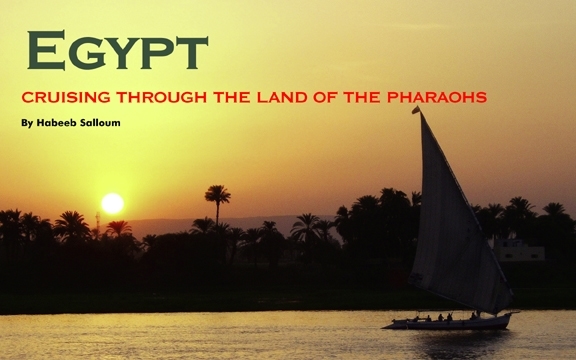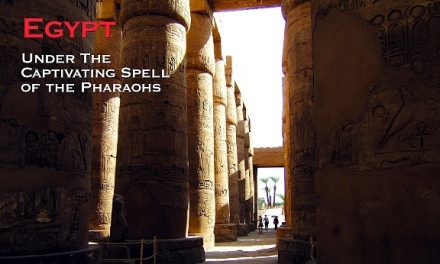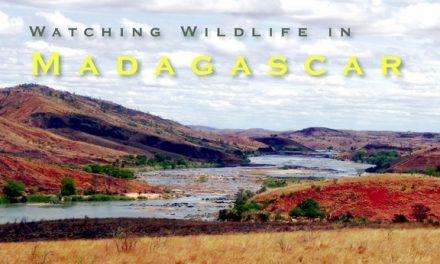Egypt
CRUISING THROUGH THE LAND OF THE PHARAOHS
By Habeeb Salloum
 The River Nile has been the lifeblood of Egypt, flowing majestically through it’s desert landscape and sustaining the people for a couple of millenia. Having the opportunity to glide down the waterway is an unforgettable experience, as it gives a sense of power and connection to the country’s main source of basic needs. Surrounded by thick flora and miles of desert beyond, the environment is a unique look into ancient past and a thriving culture today.
The River Nile has been the lifeblood of Egypt, flowing majestically through it’s desert landscape and sustaining the people for a couple of millenia. Having the opportunity to glide down the waterway is an unforgettable experience, as it gives a sense of power and connection to the country’s main source of basic needs. Surrounded by thick flora and miles of desert beyond, the environment is a unique look into ancient past and a thriving culture today.
Luxor and the scenic Nile
For two days we had toured the ancient Egyptian ruins at Luxor – both in the ‘City of the Living’ and the ‘City of the Dead’. Amid the fascinating remains of a people who had laid the basis for future civilizations, I admired the pharaonic contributions to humankind. These breathtaking monuments were still on our minds as we relaxed atop our cruise ship, Oberoi Shehrayar, on our way to Aswan.
All around me, the white sails of the Egyptian feluccas, dotting the tranquil Nile, appeared to be huge proud swans as they criss-crossed the river, seemingly bidding us adieu. Beyond were dozens of cruise ships docked or, like us, beginning on their journey to Aswan.
Wandering on the top deck of the Shehrayar, our home for the next four days, I watched the late afternoon sun shimmer on the surface of the blue waters as we made our way up river. Keeping us company were a few of the 200 cruise ships which navigate the Nile. However, soon cruise ships and feluccas were forgotten as we watched the colours of the sunset turn the Nile into a panorama of hues. By the time it was dark, we had passed through a lock in a dam across the Nile and were anchored in Esna, about 64 kilometres south of Luxor.
Esna and its Khnun Temple
Meals on the ship were delightful and enjoyed even more with new companions at the table. Like many cruises along the Nile and all over the world, communal dining allows passengers to indulge in forming new travel relationships while bonding over exotic culinary experiences.
The next morning, guides led the groups of tourists from at least a half dozen ships, streaming down the dusty streets of Esna, crowded with merchants trying to entice us with their wares. The visitors making their way to the Esna Temple seemed to saturate this agricultural town.
The Temple’s grandeur
Dedicated to Khnun, the ram-headed god who modelled people on his potter’s wheel, the Temple is a Ptolemaic building with pharaonic, Greek, Roman and Coptic elements. It took 400 years to build, but its major section was erected in the 2nd century B.C.
At one time, the Temple, completely covered with inscriptions, was almost totally concealed with debris and sand. This kept the hypostyle hall with its forest of 24 columns, each a dozen metres high, topped by capitals of flowers and plants in almost perfect condition.
Although fascinating, I was glad when we were again on our ship sailing through the upper Nile – edged by lush ribbons of vegetation between bare desert hills. In places, the green strips on both sides of the Nile were so thin that one could hardly believe that over 82 million Egyptians could make their living along its banks.
Cruising the Nile
As our cruise ship sailed up the broad loops of the Nile, winding its way through the desert, we passed village after village whose homes were built from mud-brick. All around them, the intense green of the palms and sugar fields made for a serene countryside. The romantic Nile and its edging emerald fields continued until we reached Edfu, north of Aswan.
Visiting Edfu
This idyllic aura of the villages changed for me the next day as we rode a horse-drawn carriage through the dusty streets of Edfu. It was hot and a little rough around the edges, but it was interesting seeing these small communities up close.
From the carriage, we walked with thousands of other tourists to the best preserved of Egypt’s many temples which were built to honour some 750 gods. The sand that for centuries had covered the temple and was responsible for its preservation was removed in 1860, by Auguste Mariette, the great pioneer archaeologist who was the founder of the Egyptian Museum of Antiquities.
Exploring Horus Temple
A huge temple only exceeded in size by Karnak Temple in Luxor, it is built in pure Ptolemaic style and dedicated to the falcon-headed god, Horus, the most famous deity in Upper Egypt. Built between 237 and 57 B.C., it is covered with mythological and religious decorations as well as hieroglyphic texts.
The facade of the Temple rises up in all its majesty with two splendid pylons. Inside, I stopped awhile in the courtyard lined on three sides with impressive columns – their capitals each different from the other. Moving further within, we passed through hypostyle halls and offering chambers, a few retaining some of their original colours. At the inner sacrarium which once housed the image of the god, Horus, I took a break to rest. The throngs of tourists covering every inch of space seemed to bring the massive temple back to life – almost to the time it reverberated with the prayers of priests.
Cruising through New Nubia
Back on the ship, I sunned myself around a swimming pool as the vessel purred forward in the middle of a thin line of green. Soon I were passing through ‘New Nubia’ where 100 thousand Nubians were re-settled after the building of the ‘High Dam’ near Aswan. Being hard workers, they turned the desert into a sea of sugar cane, dotted with fruit and vegetable fields. Amid this greenery, they built their villages, carrying the names of those they had abandoned to the Dam’s rising waters.
At the afternoon tea, the discussion of our group turned to the morals and dignity of the Egyptians. Some mentioned how the Egyptians were honest and how safe it was to live in the country in spite of some of the unwarranted stigmas.
Kom Ombo and its Ptolemaic Temple
That evening we docked beside the Ptolemaic Temple of Kom Ombo, dedicated to Sobek, the crocodile god of fertility, and Haroeris, the Good Doctor.
Next morning, we toured this temple of the two gods with twin entrances, built a few centuries before the Romans occupied Egypt. The temple also served as a hospital – a whole series of medical instruments are sculptured in reliefs on the temple walls. In the Chapel of Hathor, guests can see three worshipped crocodiles that have been mummified.
From Kom Ombo, the green strips of land along the river banks gradually narrowed until the barren hills reached the waterside. As we watched the greenery fade away, my thoughts turned to the works of the pharaohs and how they were drawing the tourists in the millions. Of course, giving them a hand in revitalizing the once rich lands of ancient Egypt, are the mighty Nile and the relaxing cruise ships.
Aswan and its spectacular setting
At noon we were docked in Aswan, roughly 900 kilometres south of Cairo. Here where the Nile is at the epitome of its charm we planned to relax for a few days. Walking above its banks of the river we were enchanted.
Atop a high point the river scene was truly magnificent. The river flowed through an amber desert between granite rocks and shimmering green volcanic islands, covered with palm groves and tropical plants. Embellishing this panorama of colour were the felucca ships with their tall masts and white sails covering the skyline. It is a breathtaking vista.
Later, we enjoyed the river’s view from the terrace of the Sofitel Legend Old Cataract, a charming, renovated relic of British colonialism, where Agatha Christie wrote ‘Death on the Nile’. Sipping our tea, we admired the feluccas gliding on the water around the foliage-clad rocky islets. It was a captivating scene, awe-inspiring in its beauty set in the aura of a sunset.
Touring Aswan
The pharaonic and other monuments in Aswan are many but during our two day visit we only had time to visit a few. From among these were: the unfinished Obelisk – a monument left by the ancients; the reconstructed Philae Temple; and the High Dam – a structure of which the pharaohs would have been proud.
In between our visits to the monuments, we explored the souks, full of oriental colour, then strolled the Corniche along the Nile. The edging mighty river was very appealing.
Enjoying Aswan
Aswan, like many destinations in Egypt, has much to offer. It has been a favourite winter resort since the beginning of the 19th century. For Europeans and North Americans, it is a perfect place to get away from it all, especially during the colder months back home. Spending time immersing myself in its scenic views and its monuments was a delightful climax to the cruise through Upper Egypt, land of the pharaohs.
For More Info on Egypt:
http://www.egypt.travel


















